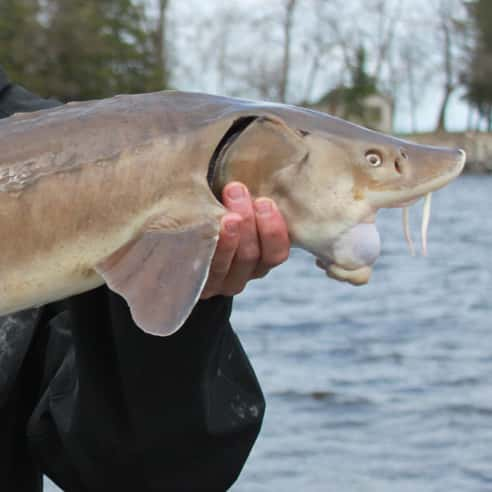
Better Left Alone? While the lake sturgeon populations in the U.S. have rebounded due to careful management practices, scientists in Europe are using genetic manipulation in hopes of restoring a semblance of a Russian sturgeon population in waters where they’ve been overharvested for caviar.
By Nick Simonson
While better reserved for a time closer to Halloween, with recent reports of successful cross-breeding between paddlefish and sturgeon meant to sustain a European caviar industry in decline due to the overharvest of the source sturgeon species, the “sturddlefish” as it’s known, is just one aquatic oddball in a list of man-made mixes of two fish species.
What follows are the tales – perhaps cautionary ones – of recent history’s strange hybrids and genetic tweaks made by man, some of which have escaped into he wild, or been purposely put there for food, sport or another reason.
Straddling the Line
While “straddlefish” would have been a better moniker for the recent attempts by Hungarian biologists to get the best traits on either side of the species barrier between an American paddlefish and a Russian sturgeon, the sturddlefish is what the makers of the roughly two-thirds sturgeon, one-third paddlefish called it. Originally planned to provide only the sperm, and not its DNA to help the endangered Russian sturgeon to develop eggs and reproduce, a number of offspring resulted from the donation of the paddlefish.
They look more like sturgeon, and the two variants have differing snout lengths. Those created species are now held in a Hungarian research facility, where the biologists assure us that they’ll never reach the open waters. That guarantee is something heard before with a fish that would never have been without man’s intervention.
Triploid Trouble
Genetically engineered to provide more meat on the body with the hope to make the fish market more profitable for a few select companies, the creation of a rainbow trout with three sets of chromosomes instead of two created what basically amounted to a massive silver football held in the mesh nets of Pacific Seafood along the Columbia River in Washington state.
In 2011, when a hole developed in the protective netting, more than 117,000 of these genetically-modified rainbow trout escaped into the waters of the flow. Their voracious appetite caused appropriate concern after their escape that they may threaten native salmon stocks, and a special season was set for the fish.
Additionally, the occurrence of triploid rainbow trout in Diefenbaker Lake in Alberta, Canada was highlighted by Field & Stream when twin brothers Sean and Adam Konrad caught world records of the modified fish in sequence. While the extra set of chromosomes increases growth of the fish, it likely limits lifespan and overall heath of the fish by creating a weaker immune system.
Big Meanie
While cross-breeding of largemouth bass and smallmouth bass is only rarely observed in the wild, for two decades starting in the 1960s, it was the focus of Dr. William Childers and his efforts to join largemouth eggs with smallmouth sperm created a fast-growing freak in his Illinois laboratory. Dubbed the “meanmouth bass,” legend has it that the good doctor observed a school of his trademark beasts attacking a woman who had ventured into a rearing pond for a swim a la the classic 1980s B horror flick Piranha, and a similar sighting of the fish teaming up to assault a dog that had waded into the water cemented the anger-oriented nickname.
Whether or not those stories are true, the meanmouth is most certainly real and originally a lab-created fish with some occasional real-world hybridization in places where smallmouth co-exist with either largemouth or spotted bass. Efforts to stock meanmouth bass as a fast-growing alternative to the parent species faded in the 1980s, and the natural hybrids are only rarely caught.
While nature provides its share of fish that wreak havoc on aquatic ecosystems – common carp, bighead carp, snakeheads and the like that are transported by man to new places – humankind has further intervened by playing God with certain species, often to their detriment, and possibly to our own fishing opportunities.
To paraphrase the fictional doctor Ian Malcom, played by Jeff Goldblum in the Jurassic Park series of movies, too often we think of if we could do something, rather than if we should do something, when it comes to the manipulation of fish for food or just for the fun of it.
